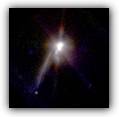|
 (Shuttle Mission: STS-82)
(Shuttle Mission: STS-82)
Shuttle: Discovery
Date: February 11-21, 1997
The Second Servicing Mission, launched February 11, 1997, greatly
improved Hubble's productivity. The installation of new instruments
extended Hubble's wavelength range into the near infrared for imaging
and spectroscopy, allowing us to probe the most distant reaches of
the universe. The replacement of failed or degraded spacecraft components
increased efficiency and performance.
Three categories of items made up the mission payload:
- Science instruments to enhance science productivity
- Primary spacecraft maintenance items
- Secondary spacecraft maintenance items
New Science Instruments
- The Space
Telescope Imaging Spectrograph (STIS) provides
 Hubble with unique and powerful spectroscopic capabilities.
A spectrograph separates the light gathered by the telescope into
its spectral components so that the composition, temperature,
motion, and other chemical and physical properties can be analyzed.
Hubble with unique and powerful spectroscopic capabilities.
A spectrograph separates the light gathered by the telescope into
its spectral components so that the composition, temperature,
motion, and other chemical and physical properties can be analyzed.
STIS's two-dimensional detectors have allowed the instrument to
gather 30 times more spectral data and 500 times more spatial
data than the previous spectrographs on Hubble. These were capable
of only looking at one place at a time.
One of the greatest advantages to using STIS is in the study
of supermassive black holes. STIS searches for massive black
holes by studying the star and gas dynamics around galactic centers.
It measures the distribution of matter in the universe by studying
quasar absorption lines. It also uses its high sensitivity and
spatial resolution to study star formation in distant galaxies
and perform spectroscopic mapping of solar system objects.
- The
Near Infrared Camera and Multi-Object Spectrometer (NICMOS)
has let us gain valuable new information on the dusty centers
of galaxies and the formation of stars and planets. NICMOS consists
of three cameras. It is capable of both infrared imaging and spectroscopic
observations of astronomical targets.
 NICMOS gave astronomers their first clear view of the universe at
near-infrared wavelengths between 0.8 and 2.5 micrometers
- longer wavelengths than the human eye can see. (The expansion
of the universe shifts the light from very distant objects toward
longer red and infrared wavelengths.)
NICMOS gave astronomers their first clear view of the universe at
near-infrared wavelengths between 0.8 and 2.5 micrometers
- longer wavelengths than the human eye can see. (The expansion
of the universe shifts the light from very distant objects toward
longer red and infrared wavelengths.)
NICMOS's near infrared capabilities have provided views of
objects too distant for research by previous Hubble optical and
ultraviolet instruments. NICMOS's detectors also perform more
efficiently than previous infrared detectors. With its cryogenics
depleted, NICMOS is now dormant and awaiting the installation
of a new cooling system in SM3B.
Primary Spacecraft Hardware replacements included the following:
- Refurbished Fine Guidance Sensor (FGS)
Hubble uses this optical sensor provide pointing information for
the spacecraft and as a scientific instrument for astrometric
science. The modification to this FGS spare added the capability
for ground-controlled alignment corrections.
- The addition of an Optical Control Electronics Enhancement
Kit (OCE-EK)
The OCE-EK provided the electronic pathway for commanding the
alignment mechanisms.
- The Solid State Recorder (SSR)
This recorder replaced one of Hubble's three Engineering Science
Tape Recorders (ESTR). The SSR provides much more flexibility
than an ESTR, which is a reel-to-reel recorder and can store ten
times more data. One of the other ESTRs was also replaced, but
with a spare ESTR unit. During SM3A mission the reel-to-reel units
were replaced with solid state recorders.
- Reaction Wheel Assemblies (RWA)
One of Hubble's four RWA's was replaced by a refurbished spare.
The RWA is part of Hubble's Pointing Control System. Spin momentum
in the wheels moves the telescope to a target and maintains it
in a stable position.
Secondary Spacecraft Hardware
- Data Interface Units (DIU)
Four Data Interface Units (DIU) on Hubble provide command and
data interfaces between the spacecraft's data management system
and the other HST subsystems. DIU-2 was replaced with a spare
unit that has been modified and upgraded to correct for failures
that occurred in the original unit.
- The Solar Array Drive Electronics (SADE)
This controls the positioning of the solar arrays. Hubble
has two SADE's of which one was replaced during the first servicing
mission. The unit that was returned from orbit has been refurbished
to correct for problems that resulted in transistor failures has
been will be used to replace the second unit, SADE-2. The SADEs
are provided by the European Space Agency, NASA's partner in the
Hubble program.
Doing the Job
The crew has taken more than 150 other crew aids and tools on
this mission. They range from a simple bag for carrying some of
the smaller tools to sophisticated, battery-operated power tools.
A seven-member crew took part in this mission. Four astronauts conducted
the planned spacewalks: Mark Lee, Gregory Harbaugh, Steven Smith and
Joseph Tanner were part of the extravehicular activity crew. Kenneth
Bowersox was the commander, Scott Horowitz was the pilot, and Steven
Hawley was the Remote Manipulator System Operator.
|